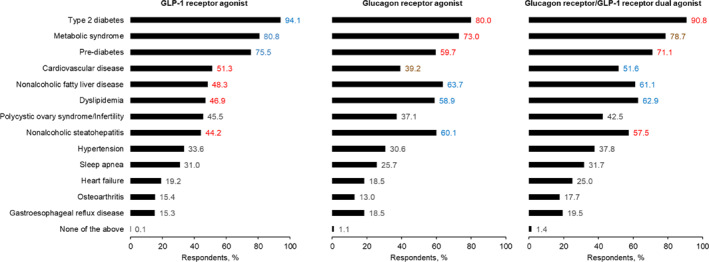FIGURE 2.

Perceived benefits of GLP‐1 receptor agonists, glucagon receptor agonists, and glucagon receptor/GLP‐1 receptor dual agonists. Respondents were asked the following: GLP‐1 receptor agonists have been shown to increase insulin secretion, decrease gastric emptying, and suppress appetite by acting on feeding centers in the brain. Glucagon receptor agonists have been shown to produce an enhanced effect on body weight reduction through effects on both the liver and adipose tissue. Targeting the liver can result in increased fatty acid oxidation, glycogenolysis, and gluconeogenesis; while targeting adipose tissue can increase lipolysis. Collectively, this can lead to a potential overall increased energy expenditure. Based on the above definition, what patient group(s) with obesity do you think would benefit most from a glucagon‐like peptide‐1 receptor agonist? What patient group(s) with obesity do you think would benefit most from a glucagon receptor agonist? What benefits, in terms of better control , would you expect from the combination of the two receptor agonists compared with the effects of either one alone (for this question, please assume that the medication is considered safe and tolerable in Phase III studies)? Please select all that apply. Data are ranked based on statistical significance at the 95% confidence interval for each patient benefit; first rank is blue, second is red, third is brown. GLP‐1, glucagon‐like peptide‐1.
